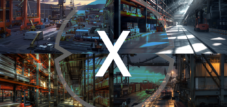US strategies to reduce dependence on China: Friendshoring – Reshoring – Nearshoring
Xpert pre-release
Language selection 📢
Published on: October 15, 2025 / Updated on: October 15, 2025 – Author: Konrad Wolfenstein

US strategies to reduce dependence on China: Friendshoring – Reshoring – Nearshoring – Image: Xpert.Digital
Goodbye China? America's 3-point plan for economic independence
America's expensive liberation: Are these strategies enough to escape China?
The global economic landscape is undergoing a tectonic shift. Driven by geopolitical tensions, national security concerns, and the painful lessons learned from the supply chain crises of recent years, the United States is pursuing a radical reorientation of its economic strategy. The goal is clear: to reduce its massive dependence on China and regain control over critical industries. But instead of a simple "China Plus One" strategy, which simply seeks an alternative location, the United States has developed a far more complex, three-pronged approach: nearshoring, reshoring, and friendshoring.
These three pillars constitute the American response to the challenges of the 21st century. Nearshoring shifts production to geographically nearby countries like Mexico to shorten supply chains and benefit from trade agreements like the USMCA. Reshoring aims to bring strategically important industries—primarily semiconductors and clean technologies—back to the country through massive government support programs like the CHIPS Act. And friendshoring focuses on building resilient supply chains with politically allied and values-based partners in Europe and Asia.
This transformation is more than just an economic policy correction; it is an undertaking backed by hundreds of billions of dollars that is redefining global trade flows, creating winners and losers, and presenting new challenges for companies around the world. While impressive successes in the form of investments and new jobs are already becoming apparent, significant hurdles remain – from high costs and skilled labor shortages to political uncertainty and persistent interdependence with Chinese intermediate products. The following analyses shed light on how these strategies work in practice, which sectors are in focus, and whether this ambitious plan can ultimately succeed.
The Great Turnaround: Why billion-dollar investments are bringing US industry back home
What alternatives to the China Plus One strategy is the United States pursuing in its efforts to achieve greater economic independence? This question concerns economic experts and politicians alike, as the United States has not developed a directly comparable strategy, but rather relies on a combination of different approaches. The American response to the challenges of global supply chains and growing dependence on China manifests itself in three main strategies: nearshoring, reshoring, and friendshoring.
Why did these strategies emerge, and how do they differ from traditional trade approaches? The development began during the Obama administration with initial containment measures, intensified under Trump with comprehensive trade wars, and was further expanded under Biden through systematic industrial policy. This evolution reflects the growing realization that economic dependence can also pose security risks.
Suitable for:
- Why companies are betting on China Plus One: Strategic diversification in a multipolar global economy
Nearshoring: The geographical realignment
Basics and motivation of nearshoring
What is nearshoring, and what role does Latin America play in it? Nearshoring describes the strategic relocation of production and procurement to geographically nearby countries. For US companies, this primarily means an increased focus on Mexico and other Latin American countries. This strategy aims to strengthen supply chain resilience, shorten transport times, and simultaneously avoid tariffs, particularly under the USMCA free trade agreement.
Mexico has established itself as a particularly attractive location. The country recorded a record $36.06 billion in foreign direct investment in 2023. Between January 2023 and August 2024, over 400 investment projects with a total volume of $170 billion were announced. These figures illustrate the enormous growth of the nearshoring trend.
The role of the USMCA agreement
How does the USMCA support nearshoring strategies? The trade agreement between the US, Mexico, and Canada creates a preferential trading area with reduced or eliminated tariffs on a wide range of products. The agreement includes streamlined customs procedures, integrated rules of origin, and modernized labor and environmental standards that meet international compliance expectations.
Mexico has already become the largest supplier of imports to the United States, with a total value of $466.6 billion in 2024, representing 15.6 percent of all US imports. This position underscores the country's strategic importance within regional manufacturing under the USMCA framework.
Sector-specific developments
Which industries benefit most from nearshoring to Mexico? The automotive industry leads the list. Mexico produced nearly four million vehicles in 2024, and the automotive sector accounted for 31.4 percent of total Mexican exports, valued at $193.9 billion. These figures reflect the deep integration with US and Canadian supply chains under the USMCA.
The electronics sector is also showing impressive growth. The Electronics Manufacturing Services (EMS) market in Mexico is expected to grow from $53.2 billion in 2025 to $97.4 billion by 2031, at a compound annual growth rate of 10.6 percent. This growth is being driven by the nearshoring of high-tech production lines, including semiconductors, telecommunications equipment, and automation systems.
Suitable for:
- Nearshoring vs. offshoring warehouse processes: The importance of buffer warehouses for flexible production processes
Challenges and limits
What problems does nearshoring entail? Despite positive developments, Mexico faces significant challenges. Security concerns due to influential drug cartels and high levels of corruption rank the country 126th out of 180 in Transparency International's Corruption Perceptions Index. In addition, public services are inadequate, and demand for industrial space exceeds supply.
Political developments under the Trump administration have created further uncertainties. In early 2025, President Trump initially imposed 25 percent tariffs on Canadian and Mexican exports to the US, before exempting vehicles from Mexico and Canada. These uncertainties could burst the expected nearshoring bubble, causing growing concern in Mexico.
Reshoring: Returning Home
Basic principles and objectives
What does reshoring mean, and why is it strategically important for the United States? Reshoring goes beyond nearshoring and aims to bring production back entirely to the home country. The United States has launched extensive tax incentives and funding programs to facilitate the return of industrial and technology companies, particularly in the semiconductor, medical technology, and electromobility sectors.
The Reshoring Initiative 2024 Annual Report shows that 244,000 U.S. manufacturing jobs were announced through reshoring and foreign direct investment in 2024. Since 2010, over two million jobs have been announced, while 1.7 million have already been filled. These figures demonstrate the continued buildup of domestic manufacturing capacity.
The role of the CHIPS Act legislation
How does the CHIPS Act support reshoring efforts? The bipartisan CHIPS and Science Act of 2022 lays the groundwork for billions of federal dollars to reshoring semiconductor manufacturing. The legislation authorized over $50 billion for semiconductor-related activities, along with 25 percent refundable tax credits for private companies that undertake projects by the end of 2026.
The effects are already visible. The Department of Commerce has announced more than $30 billion in grants and loans to prominent semiconductor companies such as TSMC, Intel, and Micron, with projects in Arizona, Texas, New York, and other states. Micron's announcement of a $200 billion investment in domestic semiconductor production represents one of the largest reshoring announcements in recent years.
Sector-specific successes and challenges
Which industries are leading the way in reshoring, and what obstacles exist? High-tech industries are driving growth: 88 percent of jobs in 2024 were in high- or medium-high-tech sectors, a share that rose to 90 percent by early 2025. The leading industries in 2024 were computers and electronics, electrical equipment (including EV batteries and solar), and transportation equipment.
Nevertheless, significant structural challenges remain. US manufacturing costs are 30-50 percent higher than those in Asian countries due to energy, labor, and raw material costs. In addition, structural gaps exist in the semiconductor value chain, including dependence on Asian upstream materials and a shortage of highly skilled labor at home.
Regional distribution and government support
Which states benefit most from reshoring? Texas, South Carolina, and Mississippi are the leading states for reshoring and foreign direct investment in 2025. The South and Midwest accounted for 81 percent of reshoring and FDI jobs.
States are increasingly developing sector-specific incentive programs, moving away from generic incentive packages and toward instruments tailored to high-value industries such as semiconductors, clean technologies, biotechnology, and quantum technologies. This strategic alignment enables states to better compete for transformative investments and align more closely with federal priorities.
Friendshoring: Strategic partnerships with allies
Conception and political development
What is friendshoring and who coined the term? Friendshoring is a relatively new strategy that involves concentrating supply chains on countries with similar political values, stable relationships, and minimal geopolitical uncertainty. The term was coined by U.S. Treasury Secretary Janet Yellen, among others, to reduce dependence on China and mitigate risks such as sanctions, trade conflicts, or export restrictions.
In a speech in Seoul, South Korea, Yellen defined friendshoring as an international economic policy that aims to "achieve free but secure trade" by favoring "the friendshoring of supply chains to a large number of trusted countries." This strategy aims to deepen relationships and "diversify our supply chains with a larger number of trusted trading partners."
Identification of strategic partners
Which countries are considered "friends" in the friendshoring strategy? Companies and the U.S. government are developing strategic value-added partnerships primarily with countries such as Canada, Mexico, South Korea, Japan, and the European countries. These countries are considered trustworthy and share similar values regarding the international trading system.
However, tensions are already emerging in the definition of "friendship." President Biden's decision in January 2025 to block Nippon Steel's acquisition of US Steel, citing national security concerns, raised questions about the permanence and reliability of the "friendship" category. Friendshoring partners may therefore question whether their friendship with the US is permanent or limited to specific situations at the discretion of the US government.
Implementation and practical challenges
How does friendshoring work in practice, and what are its results? Based on Executive Order 14017, "America's Supply Chains," the U.S. Department of Commerce identified approximately 2,400 critical goods and materials in four broad product categories: public health and biological preparedness, information and communications technology, energy, and critical minerals and materials.
The results so far have been mixed. While progress in reducing China's share of US imports has been modest, and in some cases China's share has actually increased, the consequences of Yellen's approach are beginning to become apparent. Challenges remain particularly evident in the areas of green energy and critical minerals, where China often appears to be the only producer with the scalability to meet growing demand.
Long-term strategic implications
What are the long-term effects of friendshoring on global trade patterns? The strategy is leading to a gradual realignment of US trade relations away from China and toward allied nations. However, this process is more complex than originally expected. A study shows that, following trade frictions, US companies tend to cooperate with third countries that are deeply integrated into Chinese supply chains.
This leads to longer supply chains and reduced transparency, making them more difficult for authorities and companies to monitor. Chinese goods are sometimes repackaged or minimally processed in other countries and then exported to the US, as the US Department of Commerce has confirmed in the case of solar panels via Vietnam, Malaysia, Thailand, and Cambodia.
Our US expertise in business development, sales and marketing
Industry focus: B2B, digitalization (from AI to XR), mechanical engineering, logistics, renewable energies and industry
More about it here:
A topic hub with insights and expertise:
- Knowledge platform on the global and regional economy, innovation and industry-specific trends
- Collection of analyses, impulses and background information from our focus areas
- A place for expertise and information on current developments in business and technology
- Topic hub for companies that want to learn about markets, digitalization and industry innovations
Automation as a rescue: How US factories become competitive again
Comparison of US strategies with China-Plus-One
Functional similarities and differences
How do the US strategies resemble the China Plus One strategy? All three American approaches—nearshoring, reshoring, and friendshoring—similar to China Plus One, pursue the goal of reducing the risks of concentration on a single location. They aim to increase resilience and expand control over critical supply chains and technologies.
The key differences, however, lie in their geographical focus and political motives. While China Plus One primarily aims at cost optimization and risk diversification, US strategies are strongly influenced by security policy considerations and the pursuit of technological sovereignty. The American approaches are also more strongly state-directed and underpinned by extensive funding programs.
Sectoral focuses and priorities
Which sectors are the focus of the various strategies? While China Plus One has traditionally been focused on labor-intensive manufacturing and cost efficiency, the US strategies focus on high-tech and strategically important sectors. The CHIPS Act legislation specifically targets semiconductors, while the Inflation Reduction Act promotes clean energy and electric vehicles.
This sectoral focus reflects the recognition that not all industries are equally critical to national security and economic sovereignty. The United States prioritizes sectors with high strategic relevance and technological complexity, while cost-driven, labor-intensive production continues to remain in low-cost countries.
Timeframe and implementation speed
How quickly do the various strategies take effect? The Reshoring Initiative reports that it took ten years for the first million jobs to return to the US, while the accelerated rate of one million jobs over the past four years was due to the additional influence of government incentives. This acceleration was driven by legislation such as the Inflation Reduction Act and the Biden administration's CHIPS and Science Act.
China-plus-one strategies, on the other hand, can be implemented more quickly because they primarily divert existing manufacturing capacity rather than building new ones. US strategies require the development of complex industrial ecosystems, which naturally takes more time but is also more sustainable.
Suitable for:
- City – country – logistics and future-proof logistics strategies: The integration of nearshoring and buffer warehouses
Geopolitical and economic impacts
US-China trade war and supply chain redesign
How is the ongoing trade war affecting global supply chains? The trade conflict, which has been ongoing since 2018, has led to significant structural changes at the corporate level in China. Chinese companies have responded proactively through strategic foreign investments, reassessment of supply chains, and accelerated technological modernization.
The relative importance of the United States in China's export structure has declined annually, while South-South trade between China and developing countries has steadily expanded. By 2023-2024, only about 30 percent of Chinese exports were destined for G7 industrialized countries, compared to nearly 48 percent in 2000.
Impact on third countries
What opportunities and risks arise for other countries? Attempts to reduce US import dependence on China could be beneficial for other countries. The stronger positions of developing Southeast Asian countries or Mexico in US imports represent an opportunity to develop their industries and eventually replace China as a supplier to the US market.
However, it also shows that many imports from these countries continue to rely on Chinese inputs. This is a first step toward developing domestic industrial competencies, but the process will take time. As production costs in China rise, it will become possible for other countries to compete with China, especially if the US introduces appropriate incentives.
Technological sovereignty and innovation
How do these strategies influence technological development? US strategies aim not only at relocating existing production but also at building innovative research and development capabilities. South Korea, for example, announced in June 2024 that it had established four research centers focused on cutting-edge technologies at Yale, Johns Hopkins, Purdue, and the Georgia Institute of Technology, with the number of such centers expected to rise to a dozen by 2027.
These collaborations not only create alternative supply chains but also alternative innovation networks that could, in the long term, challenge China's technological dominance in certain areas. The development of a "Chip 4 Alliance" between the US, Japan, South Korea, and Taiwan demonstrates how technological partnerships extend beyond mere trade relations.
Economic success measurement and challenges
Quantitative successes of US strategies
What measurable successes can the US strategies demonstrate? Since President Biden took office, companies have announced $276 billion in investments in American clean energy and electric vehicle manufacturing. The Inflation Reduction Act alone has catalyzed nearly $900 billion in private sector investment commitments, including approximately $400 billion in clean energy across all states.
Real investment in manufacturing structures is at an all-time high and has remained at this level for six quarters. Manufacturing's contribution to GDP broke record levels for three consecutive quarters in 2023. These figures demonstrate the material success of industrial policy measures.
Persistent structural challenges
What fundamental problems remain? Despite the successes, significant challenges remain. Frequent policy adjustments undermine investment confidence, and higher US manufacturing costs of 30-50 percent compared to Asian countries remain a key obstacle. Structural gaps in the semiconductor value chain, including reliance on Asian upstream materials and domestic labor shortages, limit the effectiveness of reshoring efforts.
China maintains a strong position in US supply chains, and companies seek simple solutions to circumvent restrictions. This is reflected in the apparent preference to shift some production to countries linked to the Chinese economy. US dependence on China for critical minerals and rare earths remains a particularly sensitive issue.
Role of automation and technology
How important is technological modernization to the success of these strategies? Blanket tariffs will not rebuild domestic manufacturing because they do not address the core challenge: the need for advanced, cost-effective production methods that make US operations globally competitive. For viable domestic manufacturing, companies must leverage automation and advanced technology—embracing robotics, AI, and real-time data systems to increase productivity.
The Cleveland Cliffs Steel Mill in Cleveland, for example, is the world's most productive steelmaker in the production of high-quality steel and has achieved this feat through extensive automation in production to maintain well-paying, unionized steelworker jobs. Unfortunately, most current automation systems in US plants still lack the precision and cost-effectiveness for complex tasks such as the assembly of small electronics.
Political continuity and change
Differences between administrations
How do the approaches of different US administrations differ? The Obama administration had already implemented comprehensive containment measures, including investment restrictions and export control systems that excluded China from access to many advanced technology products. The Trump administration intensified the containment policy with comprehensive tariffs and trade measures.
The Biden administration not only continued Trump's containment policy but also tightened its own policies. The CHIPS and Science Act and the complementary new export controls on artificial intelligence and semiconductors represent the core of this new and very comprehensive containment policy. This policy aims to "maintain as much of a head start as possible," as National Security Advisor Jake Sullivan put it.
Current political developments under Trump
What changes will the second Trump administration bring? The Trump administration appears to have no "friends," and its "Make America Great Again" goals are at odds with friendshoring concepts. Trump's recent announcements of new US tariffs, which could also be applied to friends and allies, will undoubtedly cause Indo-Pacific friendshoring partners and companies to rethink the future economic integration of the US with its "friends."
On March 31, 2025, President Trump signed an executive order establishing the United States Investment Accelerator, a new office within the Department of Commerce to oversee CHIPS implementation. This initiative focuses on reducing red tape and streamlining federal approval processes to accelerate domestic manufacturing, but also creates greater uncertainty about funding criteria.
International reactions and adjustments
European perspectives and strategies
How is Europe responding to US strategies and developing its own approaches? The European Union has developed its own measures to reduce dependence on China, but these differ from the US approach. While the US is focusing on aggressive containment, the EU is pursuing a more balanced approach that prioritizes de-risking over decoupling.
European companies must adapt to the changing geopolitical landscape, especially if they operate in US markets or depend on US technologies. This leads to complex decisions about supply chain design and technological partnerships that must meet both European and US requirements.
Asian allies and the balance between the US and China
How do Asian allies navigate between US loyalty and Chinese economic ties? Countries like South Korea, Japan, and Taiwan face the difficult task of strengthening their security and defense ties with the US while maintaining their economic ties with China. South Korea literally sits "on the fault line of the US-China divide" and must act as a "critical technology wingman" of the US without sacrificing its economic interests in China.
The development of a US-ROK technology alliance with five pillars—enhanced counterintelligence coordination, focused R&D cooperation on emerging defense technologies, increased bilateral foreign direct investment, strengthened economic security ties, and a common approach to multilateral AI regulatory regimes—demonstrates the complexity of this balance.
Suitable for:
- Nearshoring & Collaborative Platforms: Global supply chains have developed significantly in recent years
Regionalization of trade: Are we facing competing technology blocs?
Long-term sustainability of strategies
Are US strategies sustainable and successful in the long term? The sustainability of US strategies depends on several critical factors. First, policy continuity must be ensured, as frequent policy adjustments undermine investment confidence. Second, structural cost differences must be offset by productivity improvements and technological innovation.
The successes so far are encouraging, but the true test will come in the coming years, when the newly built capacities will actually have to deliver competitive products. Experience with Intel's delayed Ohio fab projects and TSMC's setbacks in Arizona shows that the road isn't always smooth.
Technological development and innovation
What role will new technologies play in shaping future supply chains? AI-related semiconductor investments are expected to exceed $250 billion by 2025. This massive investment in advanced technologies could mark a turning point where the US not only relocates existing supply chains but creates entirely new technological ecosystems.
The development of quantum technologies, advanced artificial intelligence, and new materials science could render existing supply chains obsolete and create entirely new value chains. In this scenario, the US would not only seek to compete with China but also define entirely new playing fields.
Global trade patterns of the future
How might global trade patterns evolve in the coming decades? Current trends point to increasing regionalization of global trade, with multiple competing blocs. The US is attempting to build a "democratic" trading bloc with allies, while China is expanding its Belt and Road Initiative and South-South partnerships.
This fragmentation could lead to a world in which different technological standards, trade practices, and economic norms coexist. Companies would have to choose specific ecosystems or develop complex strategies to operate in several. The efficiency of global supply chains could suffer, but resilience could increase.
The strategic realignment of the USA
While the United States has not developed a direct counterpart to the China Plus One strategy, its combination of nearshoring, reshoring, and friendshoring represents a comprehensive strategic response to the challenges of global supply chains. These strategies go beyond mere cost optimization and address fundamental issues of national security, technological sovereignty, and economic resilience.
The successes so far are impressive: over two million jobs announced, hundreds of billions in investment, and the development of new industrial capacity in critical sectors. At the same time, significant challenges remain, from cost disadvantages to skilled labor shortages to persistent dependence on Chinese supply chains.
The success of these strategies will ultimately depend on whether the United States succeeds not only in reshoring existing production but also in developing innovative new technologies and production processes that create long-term competitive advantages. The transformation of the global economy is still underway, and the final results will only become apparent in the coming decades.
The American response to China Plus One is thus not a single strategy, but a multifaceted approach that combines industrial policy measures, geopolitical considerations, and technological innovation. The long-term success of this approach depends on the ability to maintain political continuity, overcome structural obstacles, and simultaneously harness the benefits of global connectivity without incurring its risks.
Your global marketing and business development partner
☑️ Our business language is English or German
☑️ NEW: Correspondence in your national language!
I would be happy to serve you and my team as a personal advisor.
You can contact me by filling out the contact form or simply call me on +49 89 89 674 804 (Munich) . My email address is: wolfenstein ∂ xpert.digital
I'm looking forward to our joint project.
☑️ SME support in strategy, consulting, planning and implementation
☑️ Creation or realignment of the digital strategy and digitalization
☑️ Expansion and optimization of international sales processes
☑️ Global & Digital B2B trading platforms
☑️ Pioneer Business Development / Marketing / PR / Trade Fairs
Our recommendation: 🌍 Limitless reach 🔗 Networked 🌐 Multilingual 💪 Strong sales: 💡 Authentic with strategy 🚀 Innovation meets 🧠 Intuition
At a time when a company's digital presence determines its success, the challenge is how to make this presence authentic, individual and far-reaching. Xpert.Digital offers an innovative solution that positions itself as an intersection between an industry hub, a blog and a brand ambassador. It combines the advantages of communication and sales channels in a single platform and enables publication in 18 different languages. The cooperation with partner portals and the possibility of publishing articles on Google News and a press distribution list with around 8,000 journalists and readers maximize the reach and visibility of the content. This represents an essential factor in external sales & marketing (SMarketing).
More about it here:




























